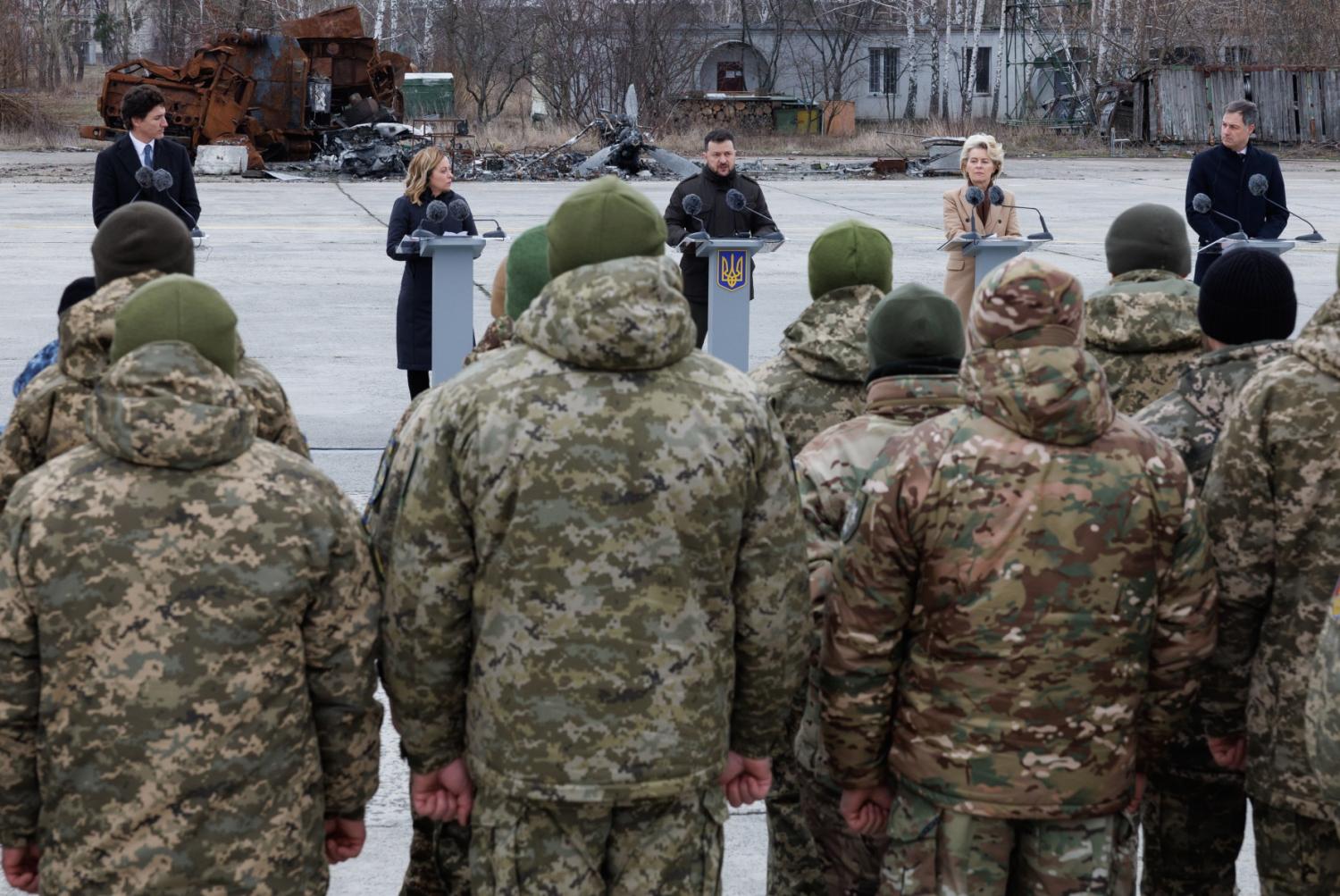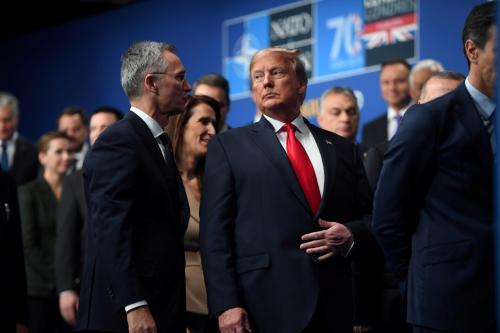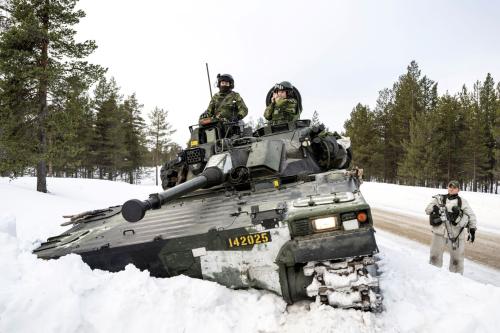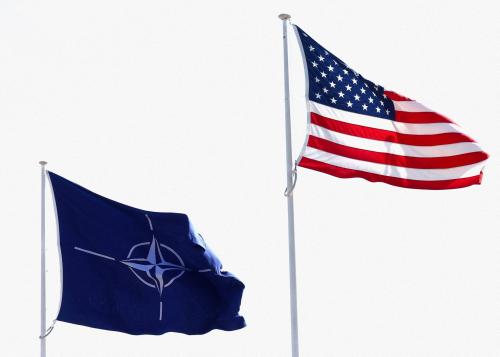The second half of 2024 is shaping up to be an anxious time for the North Atlantic Treaty Organization (NATO), the U.S.-led alliance bloc that comprises 32 member states across North America and Europe and exists to help protect each other from external threats. The Russian military continues to ravage Ukraine and menace the alliance’s doorstep, while Russia is already fighting a kind of hybrid war against member states. Meanwhile, domestic political challenges are mounting on both sides of the Atlantic. In Europe, far-right parties appear to be gaining strength, so much so in France that President Emmanuel Macron called early parliamentary elections. Marine Le Pen, the leader of France’s far-right National Rally, has advocated for taking French troops out of the U.S.-led NATO integrated command and for a rapprochement between NATO and Russia, whose president, Vladimir Putin, she has openly praised in the past.
But it is the 2024 U.S. presidential election that poses a unique threat to NATO. While European member countries continue to play frontline roles in the alliance and are focused on increasing defense needs in the wake of Russia’s full-scale invasion of Ukraine in 2022, the unavoidable reality is that the United States remains the bedrock of NATO’s ability to deter external attacks. And in 2024, the two presidential candidates hold starkly different views about the alliance’s future.
The Republican Party’s presumptive nominee, former President Donald Trump, has consistently sent mixed signals about his commitment to collective defense and privately mused that he might withdraw the United States from the alliance. Such a move would be a total reversal after four years of President Joe Biden bolstering NATO, including its expansion to include Finland and Sweden in the wake of Russia’s full-scale invasion of Ukraine.
In response to Trump’s threats, the U.S. House and Senate included a provision in last year’s National Defense Authorization Act that prohibits a president from withdrawing the United States from NATO without approval from a two-thirds majority in the Senate or a separate act of Congress.
However, the congressional move does not necessarily protect NATO from a potential second Trump term. Even if he is prevented by law from formally withdrawing the United States from NATO, Trump could use his presidential power to severely undermine the alliance and withdraw U.S. support for it in all but name. Although there has been significant debate over whether the United States should maintain its commitment to a Cold War-era alliance, it is natural for allies to expect any reduction or wind-down of the U.S. commitment to be congressionally sanctioned. Yet Trump’s long-standing and stark views on NATO and his history of abrupt action as president mean that a second Trump term could be a potential earthquake for the alliance.
What does a commitment to NATO mean?
After 75 years, NATO can seem like a piece of old furniture: For some, it feels like it has always been there, and getting rid of it would be unthinkable, while for others, it is hopelessly outdated. Founded in 1949, NATO was designed to prevent another European war in the shadow of the Soviet Union’s conquest of Eastern Europe after World War II. The first secretary general of NATO reportedly said that the alliance’s purpose was “to keep the Americans in, the Russians out, and the Germans down.”
For member countries, NATO is a broad, substantial, and high-stakes commitment, as reflected in its two key provisions, Article 5 and Article 10. Article 5 proclaims that an “armed attack” against one member of the alliance will be treated as an attack on all of them. Given that a nuclear-armed Soviet Union was the motivating threat behind the alliance, Article 5 has always carried with it the risk of escalation to nuclear war. In practice, Article 5 has only been invoked once: On September 12, 2001, the North Atlantic Council met and announced that it would invoke Article 5 to demonstrate solidarity with the United States after the terrorist attacks on U.S. soil the day before.
Article 10 opens the NATO membership door to any European country that upholds the principles of the alliance and can contribute to its security. The open door allowed for NATO’s expansion to Greece and Turkey in 1952, West Germany in 1955, and Spain in 1982. From 1999-2020, 14 Central and Eastern European nations joined NATO. And in the past two years, Finland and Sweden became NATO’s 31st and 32nd members.
These two provisions mean that if there is an attack on any of these countries, from Turkey and Estonia to France and Canada, the United States and all its other NATO allies are expected to fight as if they themselves had been attacked.
NATO has faced political challenges since its founding
It is easy to forget that NATO faced political headwinds from its inception. Moscow’s backing for a communist coup in Czechoslovakia in February 1948, followed by a Soviet blockade of West Berlin, convinced President Harry Truman to form a tight bond across the Atlantic. Through NATO, Truman sought to prevent another European war that might draw in the United States, keep the North Atlantic community secure and prosperous through free trade, and maintain the emerging postwar international order (which ultimately reinforced U.S. dominance on the world stage).
But after decades at or on the brink of war in Europe, U.S. politicians and the broader U.S. public were decidedly lukewarm about an open-ended commitment to fight on behalf of other countries. Because NATO is a treaty-based organization, Truman could not constitutionally commit the United States to join the alliance without approval from two-thirds of the U.S. Senate. Truman needed help from the internationalist wing of a divided Republican Party to get the treaty ratified in 1949. Support for international institutions like the United Nations and NATO remained an issue within the GOP, however. It was an issue in the race for the 1952 Republican presidential nomination, between the alliance skepticism of the conservative Robert Taft and the internationalist outlook of NATO’s first supreme commander, Dwight Eisenhower. Eisenhower won the nomination and ultimately the presidency, cementing U.S. support for NATO as a bipartisan endeavor.
However, the victory of the internationalist U.S. political outlook did not end NATO’s internal challenges, which persisted throughout the Cold War. Given the United States’ dramatically larger military and logistical capabilities, the Article 5 collective defense provision has always depended in practice on the credibility of the U.S. commitment to NATO. But the outsized American role in NATO has also led to tensions. NATO members in Europe make indispensable and significant military contributions to the alliance—including troops, bases, infrastructure, specialized capabilities, and crucially, the acceptance of geopolitical risk given their proximity to the Soviet Union during the Cold War and Russia today. At times, European countries chafed under American dominance of NATO’s integrated command, wanting more control over the security capabilities that affect their populations so directly.
Even as they maintained this dominance, U.S. presidents have protested since NATO’s founding that European members do not spend enough for the collective defense. Eisenhower complained, and so did John F. Kennedy. Barack Obama criticized “free riders.” Donald Trump came into office in January 2017 believing that America’s allies had long taken advantage of the United States to keep them secure. In 2014, the NATO allies set a target of spending 2% of GDP on defense by 2024. While more and more members are meeting that goal (23 as of this year), a number of them still fall short. (Stoltenberg noted in February 2024 that for the first time, NATO’s European members will collectively spend 2% of their combined GDP on defense compared to just 1.47% of their combined GDP 10 years ago.)
Still, NATO not only survived its Cold War internal challenges but also the geopolitical challenge of the end of the Cold War itself. Despite the many subsequent changes in the international security and economic environments, presidents—including Trump—have maintained the U.S. commitment to NATO. And despite the Republican Party’s dramatically increased isolationism and warmer attitudes toward Russia—thanks largely to Trump—congressional support for NATO remains strong, as illustrated by the overwhelming vote to admit Finland and Sweden, with 95 senators voting in favor.
Why NATO endures
NATO’s staying power is a break with U.S. foreign policy tradition. In his Farewell Address in 1796, President George Washington urged his fellow Americans to avoid “permanent alliances.” Many commentators have argued that NATO has long outlived its usefulness and that Europeans are overly reliant on a United States that is itself too quick to reach for military tools in general.
Why has this commitment not only endured but also expanded? In the United States, NATO appeals to different groups for different reasons, giving it significant support in different corners of Congress. Some see NATO as part of the liberal international order that protects the norms and values of democracies—and indeed, Biden has framed NATO as an alliance of democracies confronting the authoritarian threat from Putin’s Russia and a rising China. Others take a more realist view, noting the substantial capabilities NATO member countries bring to the alliance (an argument Senate Majority Leader Mitch McConnell stressed in support of Finnish and Swedish accession). NATO supporters also point to the need to protect Europe as a major U.S. trading partner against Russia and China’s economic threats.
Election 2024: Why this time could be different
Given America’s pro-NATO constituency and Congress’ role in the alliance from the beginning, could the next president of the United States withdraw the country from NATO despite last year’s legislation requiring Congress to have a role in such a move?
Presidents have become less and less constrained over time in the conduct of foreign policy. From World War II to the 1990s, Congress was a significant repository of foreign policy expertise; it is dramatically less so today. While congressional oversight and position-taking on foreign policy has always had a healthy dose of partisan and electoral politics, polarization has meant that opposition members of Congress reflexively oppose the White House. As a result, Congress conducts less oversight, bargains less frequently over policy, and is much less effective as a check on presidential authority.
A president disposed to undermine NATO could take many diplomatic and military actions unilaterally that would harm—perhaps even paralyze—the alliance. At the diplomatic level, for example, the president could decide not to appoint an ambassador to NATO. Additionally, the president could decide not to send his secretaries of state and defense and other officials to meetings of NATO defense ministers and foreign ministers or working-level meetings where much of NATO’s business gets done. Congress could haul administration officials in for questioning, but it has lost much of its inclination and capacity to conduct oversight of foreign policy in recent decades.
The president could take even more significant actions as commander in chief. For example, the president could withdraw U.S. military assets and military personnel, defanging the U.S. commitment even if it remained on the books. The president could decide not to appoint the supreme allied commander of NATO, who is based in Europe but historically has always been an American. And the president could determine (and declare) that if a NATO member state were attacked, the United States would not necessarily invoke or abide by its commitment to Article 5 to come to that country’s aid. Indeed, Trump has already said as much on several occasions. Most recently, he said at a 2024 campaign rally that he would encourage the Russians to “do whatever the hell they want” to NATO countries that do not meet their spending commitments.
This is not an exhaustive list. And even if an anti-NATO presidential effort is not entirely successful, such efforts might stir more intra-European uncertainty or antagonism, at a time when many European governments are facing domestic challenges from the far right.
In short, a president doesn’t have to formally withdraw from NATO to undermine the alliance.
NATO is on the ballot
Since February 24, 2022, Biden has led the NATO response to support Ukraine in the face of Russia’s full-scale invasion and the largest land war in Europe since 1945. Although Trump-allied GOP members in the House of Representatives delayed funding for Ukraine in 2024, ultimately, bipartisan support for Ukraine prevailed. But there are serious doubts about whether Trump would continue that response if elected president, based on his past statements supporting Putin and questioning NATO.
Additionally, many internationalist Republican members of Congress are retiring or stepping down from leadership positions—including McConnell, who is stepping down this fall as the Senate Republican leader. NATO does not seem at risk of losing significant congressional support, but the delayed Ukraine aid illustrated how few members it takes to hold up congressional action. Politically, NATO’s path will not be smooth sailing even if Biden wins reelection.
So, while congressional legislation is an important sign of bipartisan support for NATO, if the president decides that American involvement in NATO no longer serves the country’s interests, the alliance would have to somehow forge ahead without being able to rely on its most important member state. The current war in Ukraine has highlighted how dependent Europe still is on the United States for its national security. Even if the Europeans devoted more of their resources and energy to building stronger defense capabilities—as presidents from both parties have long exhorted them to do—it will take years if not decades to develop sufficient capacity.
NATO’s relevance and the degree and manner of burden-sharing remain worthy topics of debate. But the Trump-Biden 2024 rematch represents a distinct threat to the alliance given how much power the winner will have and how much Trump has learned about implementing his preferred policies since his first term. Although Congress has clearly expressed its view that the best way to keep the Russians out is to keep the Americans in, there may be little Congress can do if Trump opts for an abrupt, de facto U.S. exit from NATO.
The Brookings Institution is committed to quality, independence, and impact.
We are supported by a diverse array of funders. In line with our values and policies, each Brookings publication represents the sole views of its author(s).







Commentary
NATO is on the ballot in 2024
The treaty organization serves US interests, yet its fate hangs on the 2024 election.
June 26, 2024